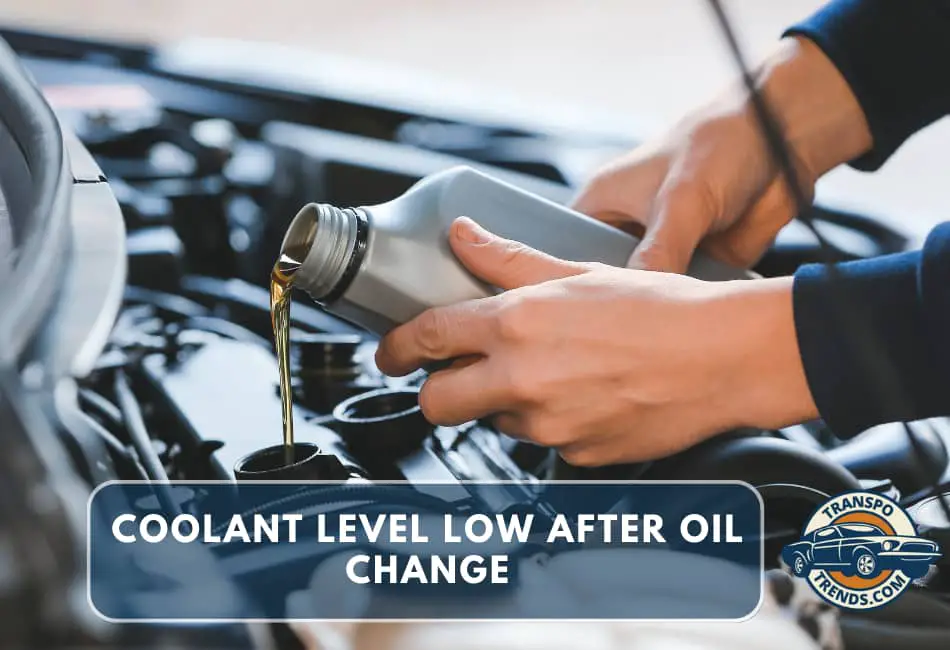Maintaining proper coolant levels in your vehicle is paramount—it regulates the engine’s temperature, protects it from overheating, and ensures it runs smoothly.
Therefore, noticing a drop in your car’s coolant level after an oil change, a seemingly unrelated maintenance task, can be quite concerning.
However, there’s no need to panic just yet! There might be several reasons behind this unexpected decrease.
In the upcoming sections, we will delve into seven possible reasons why your coolant levels might drop after an oil change, helping you better understand your vehicle and keep it in optimal condition.
1. Accidental Spillage
While seemingly unlikely, one reason for a decrease in coolant levels following an oil change could be accidental spillage.
In the bustling confines of a workshop, it’s entirely possible for the coolant reservoir to be inadvertently nudged or jostled, leading to coolant displacement.
Often, this is a minor issue. The coolant volume displaced during such incidents is usually insufficient to cause significant concern.
However, it is crucial to remember that even small amounts matter when it comes to the efficient running of your engine. Regardless of the minor spillage, it is always advisable to top up your coolant reservoir.
Keeping the coolant at the recommended level ensures the optimal performance of your vehicle and safeguards against potential overheating.
So, the next time you’re done with an oil change, take a few extra moments to check and top up your coolant if necessary.
2. Leaking Gasket or Hose
During an oil change, hoses and gaskets can sometimes develop leaks. These parts, often made of rubber or silicone, are subjected to various temperatures and pressures.
The mechanical stress involved in an oil change, coupled with the natural wear and tear these parts undergo, could potentially lead to the formation of leaks.
A. When hoses and gaskets are old, worn out, or damaged, they become brittle and are more likely to crack or rupture.
These components function as conduits or seals for the coolant, so their impairment can result in significant loss.
The wear can be so gradual that you don’t notice a problem until the coolant level drops noticeably after an oil change.
The impact of these components on coolant levels can be substantial. A leaky hose or a faulty gasket can cause the coolant to drain out, leading to an unexpected drop in coolant levels.
This could lead to increased engine temperatures reduced efficiency, and if left unchecked, can even cause severe damage to the engine.
Regular inspections of these components during routine maintenance are necessary to prevent significant problems. If a leak is noticed or if the hoses and gaskets show signs of wear or damage, they should be replaced immediately.
By proactively addressing these issues, you can maintain the proper coolant level and keep your engine running smoothly. Remember, an ounce of prevention is worth a pound of cure.
3. System Bleeding
Removing air from the cooling system, known as bleeding, is critical to vehicle maintenance.
The air in the system can create air pockets that hinder the efficient circulation of coolant. This can lead to localized overheating and reduce the performance and lifespan of your engine.
Improper bleeding of the cooling system can result in lower coolant levels. Trapped air can take up space that should be filled with coolant, causing a misleading read on the coolant level.
This can lead to insufficient coolant within the system, resulting in potential engine overheating and damage.
To properly bleed the cooling system, start with a cold engine. Slowly fill the coolant reservoir to the indicated level and remove the cap.
Next, start the engine and allow it to reach operating temperature. You’ll notice the coolant level drop as air is expelled and replaced by coolant.
Continue to add coolant as needed until the level stabilizes. Finally, replace the cap and check the level after your next drive.
Following these steps, you can ensure your cooling system is properly bled and maintains the appropriate coolant level for optimal engine performance.
4. Coolant System Overfill
Overfilling your vehicle’s coolant system can be just as damaging as not filling it enough. Filling the coolant reservoir beyond its maximum capacity can lead to the undesired release of coolant.
When the system is overfilled, the coolant has no space to expand as it heats up. This can create excessive pressure within the system, causing the coolant to be forced out through the pressure cap or other weak points in the cooling system.
The expelled coolant is not only wasteful but can also create a potential hazard on the road.
Self-adjustment During Engine Operation
During engine operation, the coolant system self-adjusts. As the engine and coolant heat up, the coolant expands.
This expansion can result in a temporary increase in the coolant level. Therefore, an engine that initially appears overfilled may self-adjust to the correct level as the engine reaches operating temperature. This phenomenon is a normal part of engine operation.
Preventing Overfilling
To prevent overfilling, checking the coolant level when the engine is cold is essential. The coolant should be at the line marked ‘cold’ or ‘min’ on the coolant reservoir.
Always add coolant slowly to avoid overfilling. If you’ve overfilled the system, remove excess coolant until it reaches the right level.
Regular coolant level checks can ensure it remains within the appropriate range, protecting your engine and maximizing performance.
5. Coolant Evaporation
Coolant Evaporation: The Phenomenon and Its Causes
In hot weather conditions, the coolant in your vehicle’s system can evaporate, particularly if the coolant mixture isn’t balanced correctly.
The coolant mixture typically comprises a 50/50 ratio of water and antifreeze. However, if the ratio leans heavily towards water, the water component of the mixture is more likely to evaporate, especially under intense heat, leaving behind a higher concentration of antifreeze.
Appearance of Coolant Loss
This process can create the appearance of coolant loss, with the coolant level appearing lower than it should be. Yet, it may not always result from a leak or overfill.
Instead, it can be an outcome of the evaporation of the water in the coolant mixture. Misinterpreting this phenomenon can lead to adding unnecessary extra coolant, which can, in turn, lead to overfill.
Maintaining Proper Coolant Levels in Varying Conditions
To prevent this, it’s essential to maintain a balanced coolant mixture, especially in hot weather conditions.
Regularly inspect the coolant reservoir to ensure the mixture is at the appropriate level and concentration. In case of uncertainty, consult a professional mechanic or your vehicle’s user manual for guidance.
Remember, it’s better to be cautious about your vehicle’s health, as improper maintenance could lead to costly or even dangerous scenarios.
Regularly monitoring your coolant level and understanding the impacts of varying weather conditions can help ensure your vehicle’s coolant system operates efficiently, regardless of the environmental conditions.
6. Coolant Leak Detection
Professionals may potentially discover pre-existing coolant leaks during routine oil changes. This is due to the close inspection of the vehicle’s undercarriage and engine compartment during this routine maintenance.
Signs of coolant leaks may include visible coolant outside the engine or ground, a low coolant level in the reservoir despite recent topping up, or the sweet smell of antifreeze.
Mechanics may also inspect hoses and connections within the coolant system for signs of leakage or damage.
Addressing these leaks promptly is of utmost importance. Coolant leaks can lead to serious engine damage if neglected.
Over time, the engine may overheat due to insufficient coolant, leading to warped engine components or a blown head gasket.
Such repairs can be costly and time-consuming, making early detection and repair of coolant leaks critical to the overall health and longevity of your vehicle. Regular oil changes are essential in identifying hidden issues within the coolant system.
Although the primary purpose of an oil change is to maintain the health of the engine’s internal components, the process also provides a valuable opportunity for a thorough inspection of other key systems, including the coolant system.
This helps identify potential issues before they escalate into significant problems, ensuring your vehicle remains reliable and safe on the road.
7. Faulty Components
An oil change is a routine maintenance task that inadvertently reveals hidden problems within the coolant system. During an oil change, mechanics may notice symptoms of a malfunctioning coolant system.
For instance, should there be degraded engine performance, overheating, or abnormal noise, these could all hint at underlying issues within the coolant system.
Certain issues, such as a failing water pump or a corroded radiator, can drastically impact the coolant system.
A faulty water pump could prevent the coolant from circulating properly, leading to engine overheating. Similarly, a corroded radiator can inhibit the heat exchange, causing the engine to overheat.
These issues could ultimately lead to significant engine damage that may be costly and time-consuming. Given the potential severity of these issues, it underscores the necessity for thorough inspections and timely repairs.
Regular checks during routine maintenance, such as oil changes, allow for the early detection of any faults. Doing so ensures that issues are addressed before they escalate into more significant problems.
It’s an integral part of maintaining the health and reliability of your vehicle, keeping it safe and efficient on the road.
Conclusion
In conclusion, there are several reasons why one might experience low coolant levels after an oil change. This could be due to leaks in the system, a malfunctioning thermostat, or an overheating engine.
It could also result from faulty radiator caps, a poor coolant mixture, or air within the system. Lastly, faulty components, such as a failing water pump or a corroded radiator, could significantly impact the coolant system.
It’s essential to understand that any coolant-related issue, if left unattended, could lead to severe engine damage, which could be costly and time-consuming to repair. Therefore, these issues must be promptly addressed.
Regular vehicle maintenance and inspections are crucial in preventing such problems. Performing routine checks allows for early detection and fixing of any faults, ensuring your vehicle’s continued reliability and efficiency.
We encourage you always to stay vigilant about the status of your coolant levels and the health of your vehicle’s coolant system. Feel free to share your thoughts or experiences on this topic in the comments below.
If you suspect any issues with your vehicle’s coolant system, don’t hesitate to seek professional assistance immediately. Remember, it’s always better to be safe than sorry when maintaining your vehicle.

